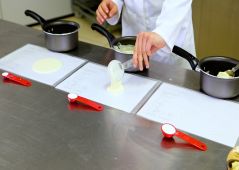Carbohydrates: gelatinisation

Have you ever made a white sauce, custard or even the filling for a lemon meringue pie? Have you wondered what causes the sauce to thicken?
How does it happen?
Take a sauce that uses flour, for example. Flour contains starch, which is a type of carbohydrate. As the starch heats up in the liquid, at about 60°C, the starch granules begin to swell and absorb the liquid. Once the mixture reaches a temperature of around 85°C the starch granules will have absorbed a large amount of water (about five times their own volume of water) and they then bump into each other, eventually bursting and releasing the starch from the granules into the liquid. The starch released into the liquid causes it to thicken. Gelatinisation is complete when the liquid reaches around 96C. As the mixture cools it thickens even more, setting and firming. It turns into a gel at about 38°C.
The effect of sugars on the thickening of the sauce
Other ingredients contained within a sauce can slow down the rate that the water is absorbed. For example, a sauce containing sugar. Sugars are also trying to absorb the liquid and are competing with the starch. This can disrupt and slow down the process, meaning it can take longer for the starch to thicken the sauce. If too much sugar is present it can completely prevent gelatinisation! Try it by adding different amounts of sugar to different samples of a basic sauce mixture.
Recap: the process of gelatinisation occurs when starch granules are heated in a liquid, causing them to swell and burst, which results in the liquid thickening.
[Note that gelatinisation is different from gelation which is the removal of heat, such as ice cream is set when it is frozen.]
More information
AQA video: Sauce making and methods of heat transfer
BNF factsheet: Food functions: Thicken
BNF factsheet: Food functions: Set
Experiment sheet: Testing for starch
Video: Making a white sauce
Starch gels freeze-thaw stability and gel strength experiment


